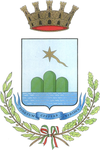Pineto
| Pineto | ||
|---|---|---|
| Comune | ||
| Comune di Pineto | ||
 |
||
|
||
| Location of Pineto in Italy | ||
| Coordinates: 42°37′N 14°4′E / 42.617°N 14.067°E | ||
| Country | Italy | |
| Region | Abruzzo | |
| Province / Metropolitan city | Teramo (TE) | |
| Frazioni | Borgo Santa Maria, Colle Morino, Croce Ferretti, Mutignano, Scerne, Torre Cerrano, Torre San Rocco | |
| Government | ||
| • Mayor | Robert Verrocchio | |
| Area | ||
| • Total | 37.69 km2 (14.55 sq mi) | |
| Elevation | 4 m (13 ft) | |
| Population (1 January 2009) | ||
| • Total | 14,430 | |
| • Density | 380/km2 (990/sq mi) | |
| Demonym(s) | Pinetesi | |
| Time zone | CET (UTC+1) | |
| • Summer (DST) | CEST (UTC+2) | |
| Postal code | 64025 | |
| Dialing code | 085 | |
| Patron saint | St. Agnes | |
| Saint day | 21 January | |
| Website | Official website | |
Pineto is a town and comune in the province of Teramo, Abruzzo, central Italy. It is a 20th-century seaside resort on the Adriatic coast, with sandy beaches shaded by pine trees that give their name to the town.
Pineto is known as one of the Sette Sorelle ("Seven Sisters"), seven Adriatic beach resorts in the province of Teramo; from north to south they are Martinsicuro, Alba Adriatico, Tortoreto, Giulianova, Roseto degli Abruzzo, Pineto and Silvi Marina. Pineto's beaches have received the "Blue Flag" (by the Foundation for Environmental Education - signifying water quality) in many years including 2007.
The Tower of Cerrano (Torre di Cerrano) is 2 kilometres (1 mile) from the town centre, at the town's southern border with Silvi Marina. It was built in the 16th century by the Holy Roman Emperor, Charles V as a watch tower to guard against attacks from the Turks and others based in what is now Croatia, 100 km (62 miles) across the Adriatic. Today, the tower houses a modern sea-biology laboratory. Future plans for this location by the Ministry of Environment, the Administration of the Province, the Administration of the City and the University of Teramo include a Sea Park.
D'Annunzio Street houses the patrician neo-classical style residences of Villa Marucci, Villa Pretaroli, Villa Caccianini and Villa Padula in Venetian style.
In front of the Torre di Cerrano lie remains of the port used by the Roman town of Adria (now Atri), which is up in the hills behind Mutignano. Mutignano is a hill town and former capoluogo of the area, that grew up in the shadow of Atri. The town has a 15th-century Romanesque church dedicated to San Silvestro, and a Baroque church of San Antonio. San Silvestro contains a mural, Tavola San Silvestro e sue storie, painted by the artist Andrea De Litio who is believed to have been born in Abruzzo.
Things started to change with the arrival of the "smooth sea road" in the early 19th century, which prompted the Filiani family to build a summer residence, the Villa Filiani. With the arrival of the Adriatic railway in 1860, this became the headquarters of their agricultural estates and industrial interests. There was much discussion whether the station should be in Atri or in the comune of Mutignano; Giacinto Filiani granted land for the construction of the Atri-Mutignano station and the prosperity of the area was ensured. Filiani built shops at the station approach, and a small community developed, but there was relatively little residential development until after World War I.
...
Wikipedia


